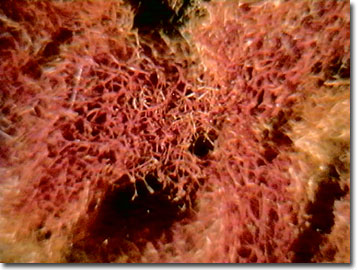Reflected Light Digital Image Gallery
Grass Sponge (Spongia species)
Known in the market as grass sponges, members of the genus Spongia include coarse, commercial natural sponges that have irregularly tufted surfaces. In Florida and the West Indies, S. graminea and S. equina supported thriving sponge diving industries until the advent of synthetic sponge materials.

View a second image of a grass sponge (Spongia species).
As members of the phylum Porifera, grass sponges feature a simple cellular structure with only two layers. The mesenchyme, a noncellular gelatinous layer between the epithelium and endothelium, features amoeboid cells that move about for transportation of nutrients, reproduction, and digestion. The structure of the commercial sponges (within the class Demospongiae) is based on a skeleton composed of spongin as opposed to the fragile glass sponges in the class Hyalospongiae that feature silicic acid, and the Calcispongiae, which have spicules made of calcium carbonate. Sponges are considered the most primitive representatives of multicellular animals and possess neither organs nor tissues. Fossil records show that sponges such as the grass sponge have changed little since they first evolved in the ancient oceans from unicellular precursors.
Before 1765, sponges were not considered benthic sedentary animals, but rather marine plants. The phylum name, Porifera, meaning "pore bearing", refers to the water circulation system displayed by sponges, comprising a central exit hole and many smaller, incurrent openings. The colonial invertebrates feed by filtering bacteria and protists from the water column as they circulate seawater through their pore structure. Other than for cleaning and bathing, natural grass sponges are used by artists and painters as alternatives to paint brushes.
Contributing Authors
Cynthia D. Kelly, Thomas J. Fellers and Michael W. Davidson - National High Magnetic Field Laboratory, 1800 East Paul Dirac Dr., The Florida State University, Tallahassee, Florida, 32310.
BACK TO THE REFLECTED LIGHT IMAGE GALLERY
BACK TO THE DIGITAL IMAGE GALLERIES
Questions or comments? Send us an email.
© 1995-2025 by Michael W. Davidson and The Florida State University. All Rights Reserved. No images, graphics, software, scripts, or applets may be reproduced or used in any manner without permission from the copyright holders. Use of this website means you agree to all of the Legal Terms and Conditions set forth by the owners.
This website is maintained by our
Graphics & Web Programming Team
in collaboration with Optical Microscopy at the
National High Magnetic Field Laboratory.
Last Modification Friday, Nov 13, 2015 at 01:19 PM
Access Count Since September 17, 2002: 21985
Visit the website of our partner in introductory microscopy education:
|
|
